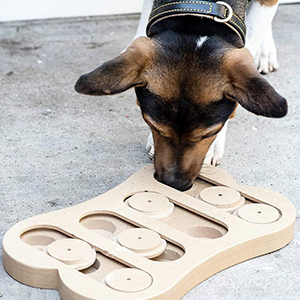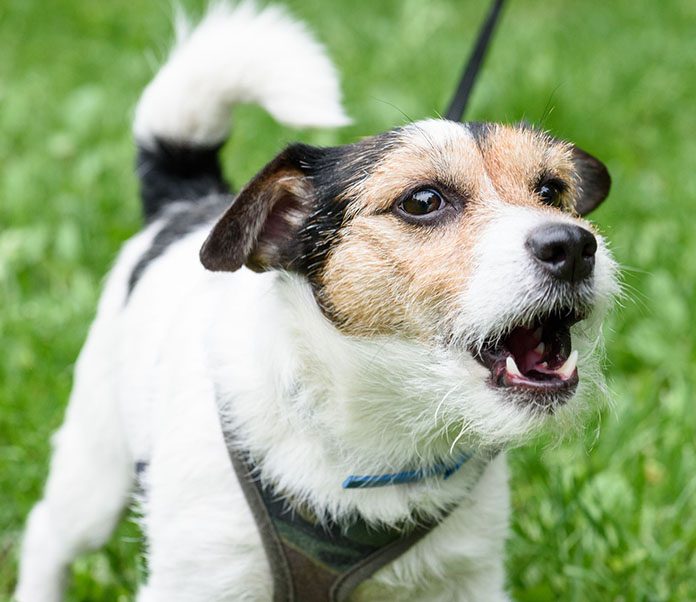It’s easy to become frustrated by what you perceive as excessive barking from your dog, but ultimately your dog is communicating with you in the only way they know how. Find out more about the reasons dogs bark and what they are trying to tell you by their different types of barks.
Why Is My Dog Barking?
Just like people use words to speak, dogs bark to vocalize their thoughts, alert us to threats and even communicate with other dogs. While barking can certainly be loud or obnoxious, it is one of the main ways our canine friends communicate with us. By paying attention to the context in which your dog is barking as well as their body language, you can take a good educated guess as to what your pup is trying to tell you.
Here are some of the most common reasons why dogs bark and tips on how to stop a dog from barking.
Common Reasons Your Dog Is Barking
- They want attention: Have you been busy cooking dinner or socializing with a friend when your dog suddenly starts barking? They likely want you to pay attention to them. Your pup could also be asking you to address a need, such as going to the bathroom, feeding them dinner or refilling their water bowl.
- They’re bored: Just like us, our dogs can easily become bored throughout the day, leading them to bark or whine. Observe their body language: Is your dog restless, wandering from room to room or continually bringing you a toy? Try providing your pup with some mental stimulation to keep them entertained, like a puzzle feeder or treat-dispensing toy. Also be sure to set aside time to play with your dog or go on walks.
- They’re frustrated: If your dog has been playing quietly and suddenly starts barking, check to see if a toy is wedged somewhere they can’t get to. Without thumbs, our furry friends can have a hard time retrieving toys and treats from small spaces. Additionally, if your dog can see out the window, maybe there’s something outside that’s causing them frustration, such as children playing across the street or a stray cat sitting in the yard.
- They’re scared: From thunderstorms to fireworks, most dogs are unsettled by sudden, loud noises. Many dogs are also afraid of everyday objects, such as the vacuum cleaner or balloons. There’s no predicting what might frighten your pup, but you can help them become less afraid of non-threatening objects through increased exposure and projecting a sense of calm.
- They’re protecting you or their territory: Many dogs bark when they feel their territory is being invaded or when their personal safety (and the safety of their humans) is threatened. If your dog is territorial, their posture will also appear threatening. Look for their tail held high and ears facing up and forward.
- They’re feeling playful or excited: Did you just come home from work and your pup is barking at you from their crate or bouncing around your feet and yapping? They’re happy to see you! At other times, your dog might be trying to engage you in playtime. If your dog leaves a toy at your feet and barks at you, they probably want you to pick it up and play with them. The same goes if your dog shows you a “play bow”: front legs down, butt in the air and tail wagging. That’s an invitation to play with them!
Other Reasons Dogs Bark
Age-related Barking
As dogs get older and their once-sharp senses begin to dull, some will pick up habits they never displayed in their youth, including excessive barking. When it comes to age-related deafness or Canine Cognitive Dysfunction (the dog version of dementia), what your pup needs more than anything is your love, care and patience. Keep your home simple and orderly, and try to avoid making frequent changes that might confuse your senior dog.
If you suspect that health issues like these might be affecting your dog, consult your vet about any medications that might help.
NOTE: If your dog is suffering from hearing loss and can’t hear your “quiet” commands, you can teach your dog hand signals instead. The trick is getting your dog to associate the signal with the behavior, much in the same way you originally taught your pup to sit. Use treats to establish a positive connection between the behavior and the hand signal. Like any training, this might be somewhat frustrating to start with, but it’s a great way to entertain and play with your your dog, and it will ultimately strengthen your bond with each other.
Underlying Medical Cause
To rule out an underlying medical reason for why your dog is barking, visit your local veterinarian if your dog exhibits unusual or excessive barking. Your vet might also have additional tips for training your dog to communicate in other, quieter ways.
Barking Is a Behavior That All Dogs Exhibit
Even “barkless” dogs such as Basenjis aren’t completely silent. While some dogs are quieter than others, there’s no such thing as a silent dog. Maintain reasonable expectations and work with your dog through positive-reinforcement training to manage excessive barking.
Remember, your dog is trying to communicate with you the only way they know how. With these helpful tips, you can begin to better understand what your pup is trying to tell you.
Picture |
Name |
Price |
Description |
 |
AmazonBasics Stainless Steel Dog Bowl | $13.99 | More |
 |
PetSafe Healthy Pet Simply Feed Automatic Cat and Dog Feeder with Stainless Steel Bowl | $99.95 | More |
 |
Zack & Zoey Basic Hoodie for Dogs | More | |
 |
SPOT Ethical Pet Interactive Seek-A-Treat Shuffle Bone Toy Puzzle That Will Improve Your Dog’s IQ, Specially Designed for Training Treats | More |






























